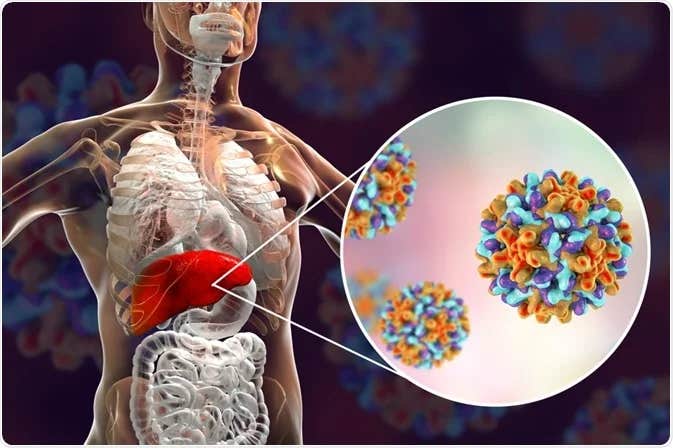Researchers solve the mystery of how deadly viruses hide in humans
Hepatitis C, first identified in 1989, is an infectious disease affecting an estimated 50 million people globally.

[July 9, 2023: Staff Writer, The Brighter Side of News]
Hepatitis C, first identified in 1989, is an infectious disease affecting an estimated 50 million people globally. (CREDIT: Creative Commons)
In a landmark scientific study, researchers at the University of Copenhagen have unveiled the mysterious strategy employed by the Hepatitis C virus to circumvent the human immune system and continue proliferating within the host. This significant discovery could pave the way for new advancements in tracking and treating not just Hepatitis C, but potentially a broad spectrum of viral diseases.
Hepatitis C, first identified in 1989, is an infectious disease affecting an estimated 50 million people globally, posing significant health risks such as chronic inflammation and scarring of the liver, and in severe cases, leading to liver cancer. Despite being one of the most intensively researched viruses, its ability to outwit the human immune system and propagate throughout the host body has remained an elusive puzzle until now.
The team of Danish researchers, leveraging a new technique for analyzing virus samples, have been the first to decode this complex viral strategy. They discovered that the virus cleverly adopts a 'mask', disguising itself in a way that confounds the immune system, allowing it to surreptitiously replicate itself and infect new cells.
"This mask enables the virus to take on the appearance of a molecule already present within our cells," explains Associate Professor Jeppe Vinther from the Department of Biology, who spearheaded the research along with Associate Professor Troels Scheel and Professor Jens Bukh from the Copenhagen Hepatitis C Program. "Disguised as this familiar molecule, the virus is able to bypass the immune response, which typically triggers upon recognizing foreign bodies."
Related News
The 'mask' in question is the molecule FAD (Flavin adenine dinucleotide), a composite of Vitamin B2 and ATP, an energy-carrying molecule crucial for cellular functions. FAD is fundamental in energy conversion within our cells, making it an ideal disguise for the virus, effectively providing it camouflage from immune system scrutiny.
For some time, the team had hypothesized that FAD was aiding the virus in maintaining stealth within the infected cells, but concrete evidence was elusive. The breakthrough came when the researchers focused on Arabidopsis, a commonly used experimental plant among researchers.
"We sought a mechanism to definitively prove our theory. This led us to isolate an enzyme from the Arabidopsis plant, which can separate the FAD molecule into its constituent parts," states Anna Sherwood from the Department of Biology, who is one of the first authors of the study, along with Lizandro Rene Rivera Rangel.
FAD capping for HCV strains of genotypes 1–6. (CREDIT: Nature)
Using this enzyme, the researchers succeeded in splitting FAD, thereby definitively demonstrating that the hepatitis C virus utilizes it as a mask to conceal itself.
The implications of these findings extend beyond Hepatitis C. Many other infectious diseases, such as the Coronavirus and Influenza, belong to the same family as Hepatitis C, known as RNA viruses. The genetic material of these viruses is RNA, which is replicated within host organisms to create new viruses that can spread to other cells.
The HCV NS5B RNA-dependent RNA polymerase initiates replication with FAD. (CREDIT: Nature)
Crucially, one end of the RNA is masked by FAD, which could suggest a common strategy among other RNA viruses for evading detection by host immune systems.
Vinther expresses optimism regarding the broader implications of their findings, "We have already found another virus using the same technique to avoid detection, and there are likely many more. All RNA viruses share a necessity to evade the host immune response, and it seems highly probable that this is a common method. Now that we've uncovered this strategy, we are in a better position to develop new and more efficient ways of detecting and treating viral infections in the future."
Demonstration of HCV RNA FAD capping. (CREDIT: Nature)
The study, which has recently been published in the scientific journal Nature, was financed by the Independent Research Fund Denmark, alongside several other Danish and European foundations. The research was a collaborative effort between Jeppe Vinther's research group at the Department of Biology, University of Copenhagen, and the research groups of Troels Scheel and Jens Bukh from the Copenhagen Hepatitis C Program, located at UCPH’s Department of Immunology and Microbiology and the Department of Infectious Diseases at Hvidovre Hospital.
With this newfound understanding of viral camouflage, we stand on the precipice of potentially groundbreaking advancements in the battle against viral diseases. The researchers' innovative use of an enzyme from Arabidopsis to unmask the virus's disguise not only provides a more comprehensive understanding of Hepatitis C but also points towards a promising direction for future virology research and disease treatment.
For more science and technology stories check out our New Discoveries section at The Brighter Side of News.
Note: Materials provided above by The Brighter Side of News. Content may be edited for style and length.
Like these kind of feel good stories? Get the Brighter Side of News' newsletter.



